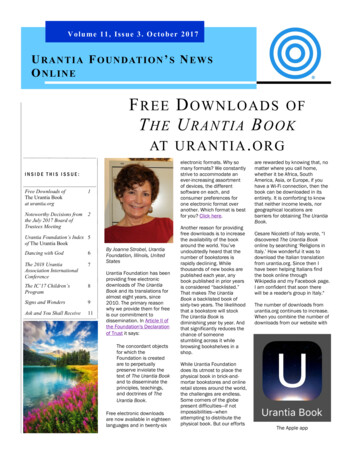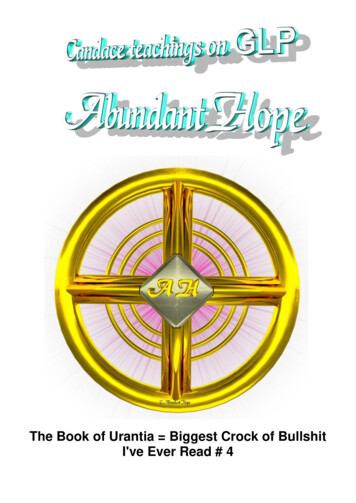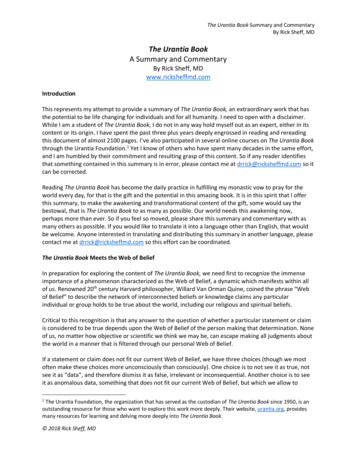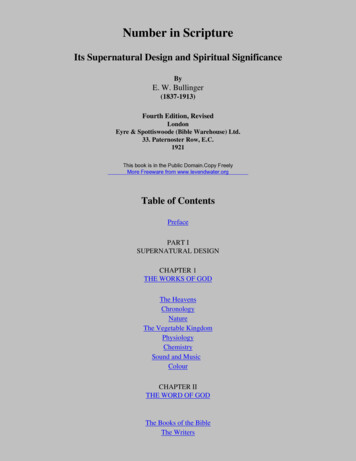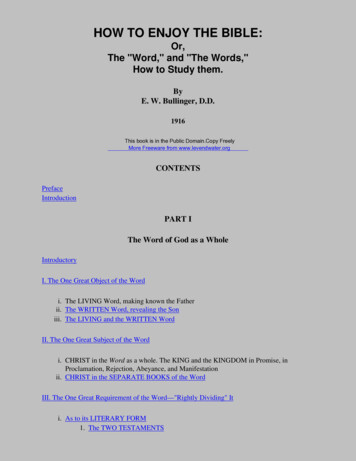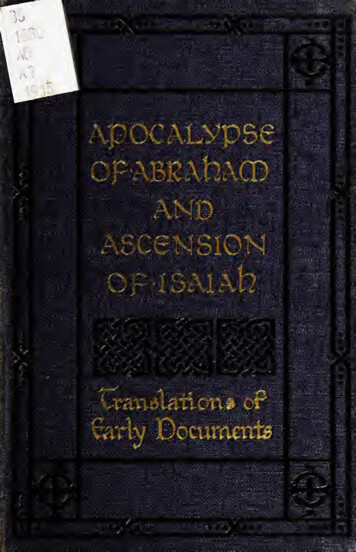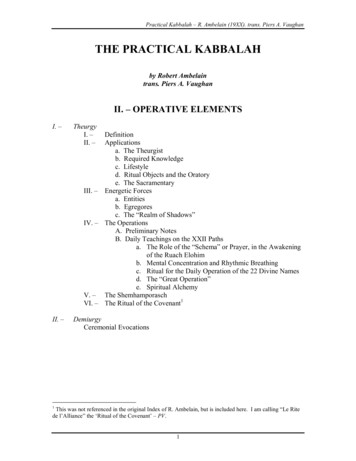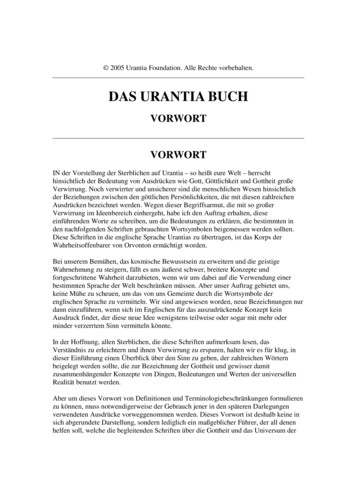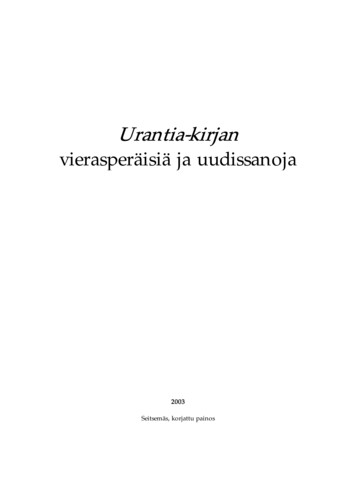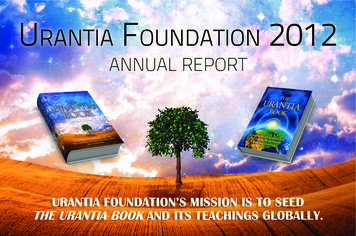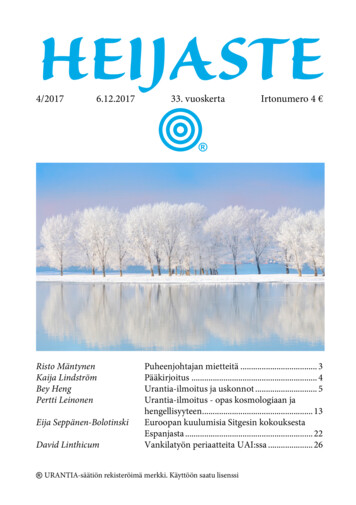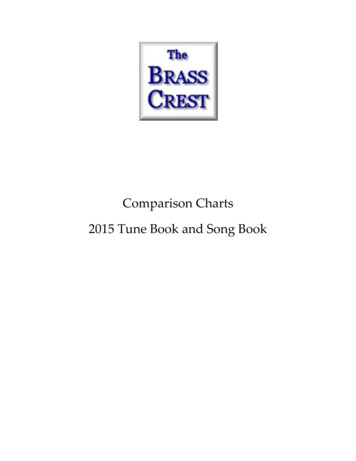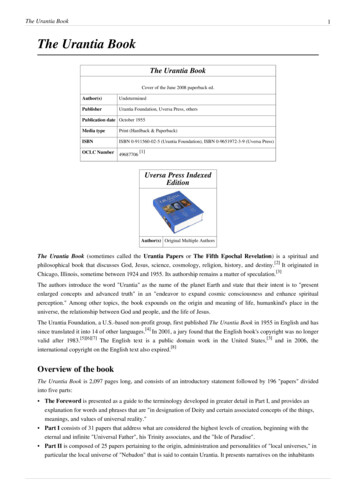
Transcription
The Urantia Book1The Urantia BookThe Urantia BookCover of the June 2008 paperback ed.Author(s)UndeterminedPublisherUrantia Foundation, Uversa Press, othersPublication date October 1955Media typePrint (Hardback & Paperback)ISBNISBN 0-911560-02-5 (Urantia Foundation), ISBN 0-9651972-3-9 (Uversa Press)OCLC Number49687706[1]Uversa Press IndexedEditionAuthor(s) Original Multiple AuthorsThe Urantia Book (sometimes called the Urantia Papers or The Fifth Epochal Revelation) is a spiritual andphilosophical book that discusses God, Jesus, science, cosmology, religion, history, and destiny.[2] It originated inChicago, Illinois, sometime between 1924 and 1955. Its authorship remains a matter of speculation.[3]The authors introduce the word "Urantia" as the name of the planet Earth and state that their intent is to "presentenlarged concepts and advanced truth" in an "endeavor to expand cosmic consciousness and enhance spiritualperception." Among other topics, the book expounds on the origin and meaning of life, humankind's place in theuniverse, the relationship between God and people, and the life of Jesus.The Urantia Foundation, a U.S.-based non-profit group, first published The Urantia Book in 1955 in English and hassince translated it into 14 of other languages.[4] In 2001, a jury found that the English book's copyright was no longervalid after 1983.[5][6][7] The English text is a public domain work in the United States,[3] and in 2006, theinternational copyright on the English text also expired.[8]Overview of the bookThe Urantia Book is 2,097 pages long, and consists of an introductory statement followed by 196 "papers" dividedinto five parts: The Foreword is presented as a guide to the terminology developed in greater detail in Part I, and provides anexplanation for words and phrases that are "in designation of Deity and certain associated concepts of the things,meanings, and values of universal reality." Part I consists of 31 papers that address what are considered the highest levels of creation, beginning with theeternal and infinite "Universal Father", his Trinity associates, and the "Isle of Paradise". Part II is composed of 25 papers pertaining to the origin, administration and personalities of "local universes," inparticular the local universe of "Nebadon" that is said to contain Urantia. It presents narratives on the inhabitants
The Urantia Book2of local universes and their work as it is coordinated with a scheme of spiritual ascension and progression ofdifferent orders of beings, including humans. Part III includes 48 papers that compile a broad history of the Earth, presenting a purported explanation of theorigin, purpose, evolution, and destiny of our world and its inhabitants. An additional 15 papers cover varioustopics such as "Religion in Human Experience", the concept of the Thought Adjuster, "Personality Survival", and"The Bestowals of Christ Michael". Part IV is presented in 77 papers and narrates "The Life and Teachings of Jesus". Included are papers about hischildhood, teenage years, family life, public ministry, and the events that led to his crucifixion, death, andresurrection. It continues with papers about appearances after he rose, Pentecost, and finally, "The Faith of Jesus".Part IV illustrates many of the concepts presented in the first three parts through the story of Jesus' life.AuthorshipThe exact circumstances of the origin of The Urantia Book areunknown. The book and its publishers do not name a human author.Instead, it is written as if directly presented by numerous celestialbeings appointed to the task of providing an "epochal" religiousrevelation. For each paper, either a named celestial being, an order ofbeing, or a group of beings is credited as its author.[9][10][11]As early as 1911, William S. Sadler and his wife Lena Sadler,physicians in Chicago and well known in the community, are said tohave been approached by a neighbor who was concerned because shewould occasionally find her husband in a deep sleep and breathingabnormally.[3][9] She reported that she was unable to wake him at thesetimes. The Sadlers came to observe the episodes, and over time, theindividual produced verbal communications that claimed to be from"student visitor" spiritual beings.[3] This changed in early 1925 with a"voluminous handwritten document", which from then on became theregular method of purported communication.[3] The Sadlers were bothrespected physicians, and William Sadler was a debunker ofparanormal claims, who is portrayed as not believing in thesupernatural. In 1929, he published a book called The Mind atMischief, in which he explained the fraudulent methods of mediumsand how self-deception leads to psychic claims. He wrote in anappendix that there were two cases that he had not explained to hissatisfaction.[12]The other exception has to do with a rather peculiar case ofpsychic phenomena, one which I find myself unable to classify,and which I would like very much to narrate more fully; I cannotdo so here, however, because of a promise which I feel underobligation to keep sacredly. In other words, I have promised notto publish this case during the lifetime of the individual. I hopesometime to secure a modification of that promise and be able toreport this case more fully because of its interesting features. Iwas brought in contact with it, in the summer of 1911, and I haveWilliam S. SadlerLena K. Sadler
The Urantia Bookhad it under my observation more or less ever since, having been present at probably 250 of the night sessions,many of which have been attended by a stenographer who made voluminous notes.A thorough study of this case has convinced me that it is not one of ordinary trance. While the sleep seems tobe quite of a natural order, it is very profound, and so far we have never been able to awaken the subject whenin this state; but the body is never rigid, and the heart action is never modified, though respiration is sometimesmarkedly interfered with. This man is utterly unconscious, wholly oblivious to what takes place, and unlesstold about it subsequently, never knows that he has been used as a sort of clearing house for the coming andgoing of alleged extra-planetary personalities. In fact, he is more or less indifferent to the whole proceeding,and shows a surprising lack of interest in these affairs as they occur from time to time.Eighteen years of study and careful investigation have failed to reveal the psychic origin of these messages. Ifind myself at the present time just where I was when I started. Psychoanalysis, hypnotism, intensivecomparison, fail to show that the written or spoken messages of this individual have origin in his own mind.Much of the material secured through this subject is quite contrary to his habits of thought, to the way in whichhe has been taught, and to his entire philosophy. In fact, of much that we have secured, we have failed to findanything of its nature in existence. Its philosophic content is quite new, and we are unable to find where verymuch of it has ever found human expression.In 1924, a group of Sadler's friends, former patients, and colleagues began meeting for Sunday intellectualdiscussions, but became interested in the strange communications when Sadler mentioned the case and read samplesat their request. Shortly afterwards, a communication reportedly was received that this group would be allowed todevise questions and that answers would be given by celestial beings through the "contact personality".Sadler presented this development to the group, and they generated hundreds of questions without full seriousness,but their claim is that it resulted in the appearance of answers in the form of fully written papers. They became moreimpressed with the quality of the answers and continued to ask questions, until all papers now collected together asThe Urantia Book were obtained. The group was known as the Forum. A smaller group of five individuals called theContact Commission, including the Sadlers, was responsible for gathering the questions from the Forum, acting asthe custodians of the handwritten manuscripts that were presented as answers, and arranging for proofreading andtyping of the material.[9]The Sadlers and others involved, now all deceased, claimed[13] that the papers of the book were physicallymaterialized from 1925 until 1935 in a way that was not understood even by them, with the first three parts beingcompleted in 1934 and the fourth in 1935. The last Forum gathering was in 1942. Also documented are methods ofreception that Sadler denied as the way the papers were received.[10]After the last of Part IV was obtained in 1935, an additional period of time supposedly took place where requests forclarifications resulted in revisions. Sadler and his son William (Bill) Sadler, Jr. at one point wrote a draftintroduction and were told that they could not add their introduction because "A city can not be lit by a candle."[14][15]The Foreword was then "received." Bill Sadler is noted to have composed the table of contents that ispublished with the book.[16]The communications purportedly continued for another two decades while members of the Forum studied the bookin depth, and according to Sadler and others, permission to publish it was given to them in 1955. The UrantiaFoundation was formed in 1950 as a tax-exempt educational society in Illinois,[17] and through privately raisedfunds, the book was published under international copyright on October 12, 1955.Only the members of the Contact Commission witnessed the activities of the sleeping subject, and only they knewhis identity.[3] The individual is claimed to have been kept anonymous in order to prevent undesirable futureveneration or reverence for him. Martin Gardner states that an explanation concerning the origin of the book moreplausible than celestial beings is that the Contact Commission, particularly William Sadler, was responsible.Gardner's conclusion is that a man named Wilfred Kellogg was the sleeping subject and authored the work from hissubconscious mind, with William Sadler subsequently editing and authoring parts.[9] A statistical analysis using the3
The Urantia BookMosteller and Wallace methods of stylometry indicates at least nine authors were involved, and by comparativelyanalyzing the book against Sadler's The Mind at Mischief, does not indicate authorship or extensive editing bySadler, without ruling out the possibility of limited edits.[3]TeachingsNature of GodAccording to The Urantia Book, God is the creator and upholder of all reality—an omniscient, omnipresent,omnipotent, infinite, and eternal spirit personality. The most fundamental teaching about God in the book is that he isa Father. "The face which the Infinite turns toward all universe personalities is the face of a Father, the UniversalFather of love."[18] Even during the development of numerous other themes in The Urantia Book, God as a lovingFather is emphasized as the central, unifying attitude of God toward the universe.God is inherently kind, naturally compassionate, and everlastingly merciful. And never is it necessary that anyinfluence be brought to bear upon the Father to call forth his loving-kindness. The creature's need is whollysufficient to insure the full flow of the Father's tender mercies and his saving grace. Since God knows all abouthis children, it is easy for him to forgive. The better man understands his neighbor, the easier it will be toforgive him, even to love him.[19]God is said to be a mystery though because of the infinite scope of his perfection and his attributes.God is not hiding from any of his creatures. He is unapproachable to so many orders of beings only because he"dwells in a light which no material creature can approach." The immensity and grandeur of the divinepersonality is beyond the grasp of the unperfected mind of evolutionary mortals.[20]God, according to the book, is one Deity who functions on a range of different levels of reality, both personal andimpersonal. God is taught to exist in a Trinity of three perfectly individualized persons who are co-equal: God theFather, God the Son, and God the Spirit. These persons are referred to by additional titles in the book, primarily asthe "Universal Father", "Eternal Son", and "Infinite Spirit". While stating that the concept of one God in threepersons is difficult to fully understand, the book says that the idea "in no manner violates the truth of the divineunity. The three personalities of Paradise Deity are, in all universe reality reactions and in all creature relations, asone".The Father, Son, and Spirit are considered "existential" persons of Deity, those in existence from the eternal past tothe eternal future. In addition, three persons of Deity are described who are "experiential", or incomplete and in theprocess of actualizing: God the Supreme, God the Ultimate, and God the Absolute. Of these three, God the Supreme,or "the Supreme Being", is given the most explanation, as the person of Deity evolving in time and space to unifyfinite reality and the infinite. The persons of God the Ultimate and God the Absolute are considered to be remotefrom the possibility of comprehension and are covered on a limited basis.Many types of celestial beings are enumerated in the book, and one of particular note is a joint "offspring" of theUniversal Father and Eternal Son called a "Creator Son". A divine Creator Son is considered the full representationof the Universal Father and Eternal Son that is possible to people. Jesus of Nazareth is identified as a Creator Sonwho incarnated on Earth and whose life and teachings are portrayed as the fullest revelation of the personality andattitude of God ever given to humanity.The final paper states:[21]To "follow Jesus" means to personally share his religious faith and to enter into the spirit of the Master's life ofunselfish service for man. One of the most important things in human living is to find o
The exact circumstances of the origin of The Urantia Book are unknown. The book and its publishers do not name a human author. Instead, it is written as if directly presented by numerous celestial beings appointed to the task of providing an "epochal" religious revelation. For each paper, either a named celestial being, an order of being, or a group of beings is credited as its author.[9][10 .
